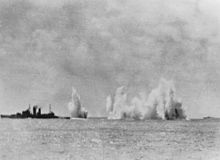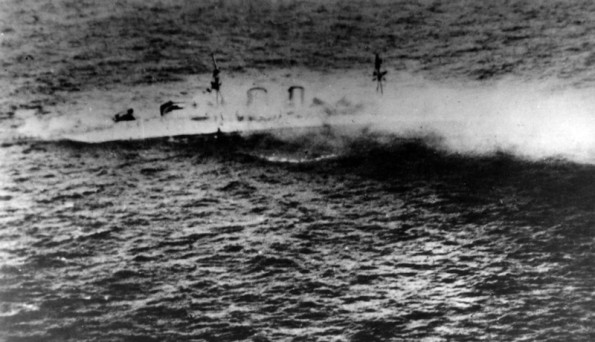Java Sea
The full story of H.M.S. Exeter's gallant end, fighting against impossible odds off the coast of Java, reached the Admiralty in December 1945. The cruiser, famous for her part in the glorious battle against the Admiral Graf Spee off the River Plate, was sunk on March 1, 1942.
She had already been damaged in the Battle of the Java Seas two days previously; but, with her escorting destroyers H.M.S. Encounter and U.S.S. Pope, she went down fighting four Japanese heavy cruisers and five destroyers. Her commanding officer, Caption O. L. Gordon, M.V.O., R.N., brought the official story of this action back with him from a prisoner of war camp; he made complete records while a prisoner and kept them from the Japanese by hiding them in a tube of shaving cream.
On February 27, 1942, she was at sea as part of an Allied force of five cruisers and nine destroyers. In the afternoon, an enemy force of four cruisers and twelve destroyers was encountered and engaged. Later the enemy was reinforced by several more cruisers. A series of actions developed in which the Exeter was damaged and two Allied destroyers and two cruisers sunk. An enemy cruiser was sunk, one probably sunk and one damaged and three enemy destroyers were seriously damaged.
H.M.S. Exeter returned to Surabaya. There was no time for proper repairs to her damaged boiler-room, and on February 28 she sailed at dark with six of her eight boilers out of action. She was accompanied by H.M.S. Encounter and U.S.S. Pope. At the time it was known that very powerful Japanese naval forces were in or near the Java Sea, but it was hoped to avoid them.
At first H.M.S. Exeter could only limp along at 15 knots, but superb work by engineering staff got two more boilers going and speed was increased at midnight to 23 knots. During the night the Exeter and her little company met an enemy force but managed to elude it. In the morning another enemy force was seen, and the Exeter doubled in her tracks, hoping she had not been seen. But two enemy cruisers began to bear down on the already crippled cruiser and her two destroyers. A little later a large enemy destroyer appeared ahead and almost immediately afterwards two other cruisers and more destroyers came into view.
All Power on the Ship Failed
The engineering staff at the last minute managed to repair one more boiler, and at 26 knots Exeter, with the two destroyers in station either side of her, steamed into action. She had only 20 per cent of her main armament ammunition remaining after the previous battle. The fight began at 09.35. The destroyers tried to ward the enemy off by firing torpedoes and to screen the Exeter by making smoke. One enemy cruiser was hit by torpedoes from the U.S.S. Pope. Several other ships were hit by gunfire from all three Allied vessels. But the end was not far off. As Captain Gordon reported, “A review of the situation at about 11.00 was not encouraging.”
At 11.20 the Exeter received a vital hit in “A” boiler room. Main engines stopped and all power on the ship failed. She was being straddled and hit by the enemy cruisers now, and orders were given to sink her and abandon ship. She sank at about 11.50. Shortly afterwards H.M.S. Encounter was also sunk. U.S.S. Pope remained at hand to the end, and then managed to escape in a rain squall, only to be sunk an hour later following an attack by Japanese bombers.
The cruiser HMS Exeter had sustained serious damage. On 28th she buried her 14 dead at sea and departed with the destroyers HMS Encounter and USS Pope. Between Java and Borneo they encountered eight Japanese warships – four heavy cruisers and four destroyers and the Second Battle of the Java Sea followed.
On Sunday, March lst, 1942, at 7.30, the topmasts of two Japanese heavy cruisers were sighted and Exeter turned south until they were out of sight, then resumed a westward course. At 9.30, they were sighted again to starboard with a large destroyer, and shortly afterwards two smaller cruisers with five destroyers appeared on the port side. Exeter turned to the eastward with her escorting destroyers, the British Encounter and the American Pope, to put the enemy astern.
For two hours a running fight ensued. The ship was straddled many times but never hit until at 11.30 one shell penetrated the boiler room. It was a shot in a million as it cut her one remaining main steam pipe.
The ship just came to a stop in all departments. The main engines stopped through lack of steam. The dynamos stopped. The turrets were motionless on different bearings. The steering failed. The inside became full of smoke as escaping oil fuel in the forward boiler room burst into flames. There was nothing that could be done do except sink her.
So the magazine valves were opened. The condenser inlets were allowed to flood the engine room, and watertight doors usually kept closed were opened. A pretty good inferno was going on down below as the fire spread. She started to list slightly to port, pouring black smoke out of her funnels. She looked defiant, like a stag at bay. Men were cutting down carley floats and flotanets, casting timber adrift, turning out boats.
The Japanese were starting to hit her now as the range closed in. The after superstructure caught fire and the whine of projectiles sounded like the Ride of the Valkyries. She was getting lower in the water and heeling more. The inside had been completely evacuated; no one could live down there. At the bottom of the ladder leading to the upper deck were a lot of people, all quite calm. She was very nearly stopped, and men were leaving in dribs and drabs. As they went they drifted away astern.
A little later, a destroyer closing on the starboard beam fired a torpedo. It was a good shot as it hit her right amidships. The old dear shuddered a bit. She seemed to shake herself from bow to stern. She must have had very little positive buoyancy left as she went right over to starboard until her funnels and masts were horizontal. Then, heaving herself up in a final act of defiance, she disappeared in a swirl of water, smoke and steam.
Article: The 'Nightmare' Night the USS Houston Went Down, makes reference to HMS Exeter numerous times; Click Here



